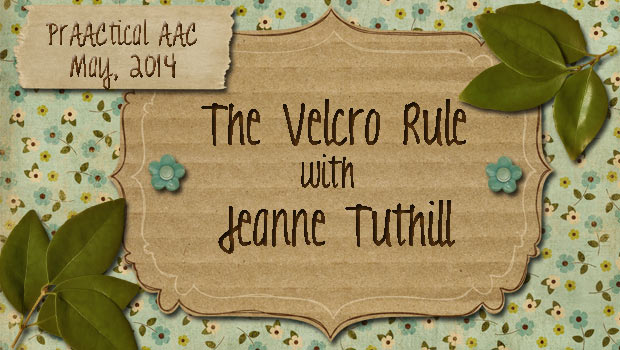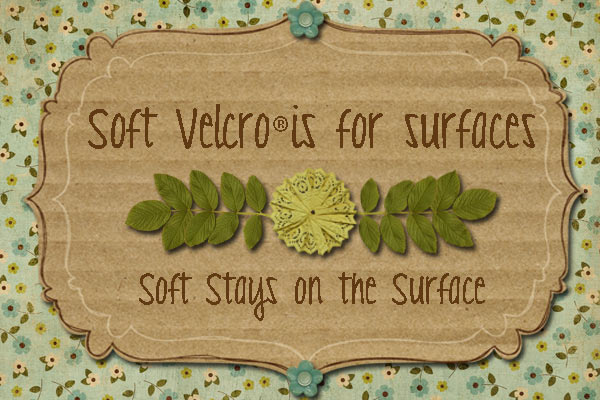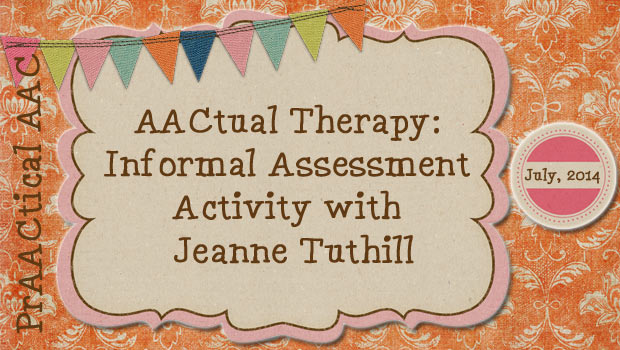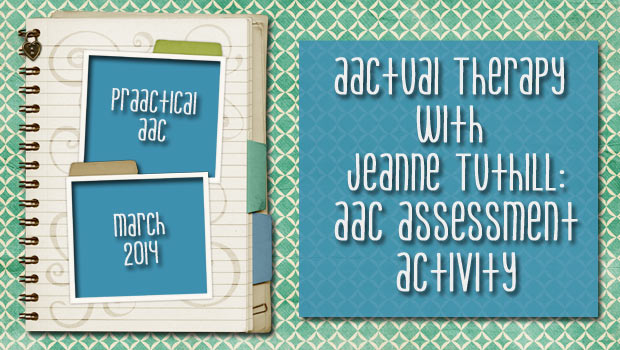The Velcro Rule with Jeanne Tuthill

We’re happy to have SLP Jeanne Tuthill back with a brief post on one of our all-time favorite products. Since we have a few folks who are new to AAC, we thought it would be great to review this simple guideline. We’ve known to break a few rules but this one is sacrosanct.
::::::::::::::::::::::::::::::::::::::::::::::::::::::::::
Recently, on PrAACtical AAC, there was a blog post that poked a little fun at fellow practitioners with a tongue-firmly-in-cheek list of ways to determine if you might be an AAC therapist (You Might be an AAC Therapist If…). I am guilty of far too many items on that list (Hello, my name is Jeanne and I am an AAC therapist…) and I even added a few of my own idiosyncrasies in the comments section – just for good measure! One of the things I added to the list was: “You get irrationally upset when someone doesn’t follow the Velcro® Rule.” My comment led another reader to request clarification of the “Velcro® Rule” and Jane Farrall even suggested that I write up the official Velcro® Rule so that everyone had access to it and could share it with others.
So, without further ado, I give you The Velcro® Rule…
To clarify that a bit further, Velcro® has two sides which can commonly be referred to as “rough” and “soft”. The soft side of the Velcro® most closely resembles the soft fabric that is used to create Velcro-sensitive surfaces on commercially available visual displays – such as the amazing array of displays that can be purchased from Augmentative Resources, Inc. You can also create your own Velcro-sensitive displays by using “headliner fabric.” This is the fabric that lines the ceiling of cars and it can be found in most retail fabric stores or at various online sources. Soft Velcro® (or Velcro® sensitive fabric) is what you need to use for anything that will be considered the SURFACE onto which picture cards/icons will be placed in the environment. Once you have all those lovely soft Velcro-sensitive SURFACES you need to use the “rough” Velcro® for your icons/picture cards so that all your picture cards will consistently stick to all your surfaces!
Velcro® is a registered trademark of Velcro Industries B.V.
Filed under: PrAACtical Thinking
Tagged With: Jeanne Tuthill, Velcro Rule
This post was written by Carole Zangari





35 Comments
Another tongue in cheek way of remembering the rule: the female (soft side) is on the bottom and the male (hard side) is on top.
Brilliant! I love that you turned it into its own blog post so that we share it with all!
Thanks for giving the suggestion to make it ‘official’! 🙂
People often forget to exain why.
I assume it’s so that AAC users are less liky to damage themselves on the soft side?
I think it is definitely a good idea that helps protect tender skin from abrasion but it also makes it so much easier to create your own soft surfaces using headliner fabric – so there is more than one PrAACtical reasons for doing it that way! 🙂
I just have to reply to this! Haha. My Velcro rule is the OPPOSITE! Why? You might ask. Because PECS books from Pyramid Education Consultants come with the hard Velcro to put on the book. Therefor all pictures need soft Velcro on the back. Should we contact Pyramid and tell them they are breaking the rule and have caused chaos among the SLP AAC community?! “As the world turns…”
I’ve never used “official” PECS products, preferring DIY versions. Interesting to know that they have the opposite approach. I’d be curious to know their reasoning!
I know I shook my head while reading this, because I was taught in PECS training “hook on the book” so all the materials I have made are the opposite of this rule. Now I feel conflicted!!!!
I agree! “Hook on the book” is the rule at our building!
I have been taught for years that it was “hard” on “hard” and “soft” on “soft” meaning the things that stay are where we put the rough velcro. I do use this idea for cleaning purposes on tables, etc. You can clean the rough velcro, but not the soft… this is a huge debate in our district and causing many issues as students move up in grades or into other rooms. Curious if other districts have a protocol they follow… Thanks!!!
I go by the rule: “Soft on the surface and Rough on the Run.” The other day I was told this was backward. This did not sit well with me so I decided to do some research. I think that the reason PECS does it the other way is because they go by Apple’s philosophy: “Let’s make it so that it will only work with our products…Our way is the only way.” Here is an adaptation for anyone facing the soft to soft problem; take a 2 inch piece of rough sticky-back velcro, cut it in half and stick it to itself, so that you have rough on both sides. Now use that between your soft surface and the soft symbol. The opposite can be used for die-hard PECS followers.
Great tip!! Thanks so much, Kristine!
Woo Hoo! I follow the Velcro rule! (and I didn’t even know there was such a thing!) Another thing to keep in mind… if you don’t follow the rule, kiss your nice sweaters good-bye. The sleeves will all be snagged up by the end of the season. Every time you reach across, you put your wardrobe in jeopardy!
Another great reason – wardrobe protection! 🙂
Thanks so much Jeanne! I hate seeing a child get scratched up arms from having the rough Velcro stuck on his or her wheelchair tray. Now I find myself singing “Soft is for Surfaces. Sss, sss, sss!”. Hopefully that will stick in other people’s heads too!
A great point and one that I failed to mention — putting soft on surfaces also protects tender skin!
YES! It makes me CRAZY when I see this rule broken. I’m compelled to peel the Velcro off and fix it everytime…which is frankly very difficult to do. Great post on a simple rule that makes a big difference in day to day practice! 🙂
Thanks, Vicki! Nice to know that I’m not alone! LOL
“Soft stays, rough roams”
I love the different ways people have for remembering this rule!
I always did the opposite! I hate that the little PECS would stick to everything if they had the rough side on them so I always put the soft on the picture 🙂 Sorry!
“Rough” roams, “soft” stays 🙂
I’m an “old timer” to AAC. I can say that l “soft receives” is a simple way to remember where the soft Velcro goes. That’s how I learned it many years ago. If sharing pictures with someone else at any point in your career, it sure makes it nice if everyone has them the same. I have many with both kinds of Velcro on the back.;-)
Another good point… Sharing is easier if we are consistent with how we use our Velcro!
I just want to say that I am so happy others have the same debate. Personally, I agree with this rule, but our preschool teachers were always taught the opposite. I also agree with the poster who felt that PECS products were the opposite way so that we would have to buy more of their products. Thanks to the person who gave the tip to make it work.
I am very surprised to see that you have the rule precisely the opposite as we do it in the computer/electronics industry. Our rule is that the soft side goes on the detatchable objects, while the rough side goes on the wall. And for components you want to stack, stuck one on on top of the other, soft goes on the bottom.
The reason you want this rule is that it is quite likely that the removable parts will be removed, taken somewhere, and placed on a different surface — say a wood or glass table. And our rough sided velcro can, and will scratch such surfaces.
Your rough sided velcro must be a lot less rough than ours, if this isn’t a constant source of aggrevation for you.
I read many comments but do agree with the peeps who use soft velcro on the moveable item and hard on the surface considered the “hook to” surface. The reason I’ve always done this is that hard velcro sticks to everything: clothes, carpets, etc. and can gather lint rendering it unusable over time. Who wants that when it’s so $$?
This was a great reading and learning web site. I wanted to know the right way to attached the velco (hard vs soft). Thanks everyone for all the different ideas, reasons, etc. And thanks to person(s) for posting & managing the site. I now fill educated enought to start my project and to choose which side (Hard vs soft) to make stationary and which to make mobile. Tim
Another thing to consider is that the part that the student is supposed to touch and hold is the picture, and if the rough Velcro (hooks) is on the back of that picture, some students may get distracted by it because they may tend to stim on it (i.e., keep rubbing their fingers on it because they like the bumpy feel of it so much), and then they also may not want to let go of the picture card to place the picture onto the surface anymore, and it can become a frustrating experience for them each time they have to place a picture, and a slowed down process for all involved.
Also, if something falls to the floor, it is more likely to be the picture card because it is the part being handled and moved, not the surface, and since the rough Velcro (hooks) tends to collect lint when it contacts the floor, there could be an increased chance of getting lint in the Velcro from the floor if the rough Velcro (hooks) is on the picture.
I don’t know how the risk of lint from the floor (from having the rough side on the back of the pictures) (soon making the card unusable unless or until you have time to clean the lint out of the hooks) compares to the risk of destroyed sweaters (from having the rough side on the surface) (possibly making the sweater immediately “unusable”).
So I am not saying which I think it should be. I’m just bringing up the issues of stimming on the (rough Velcro on the) picture card, and of the (rough Velcro on the) card falling to the floor and collecting lint. Thanks.
This is so helpful! Never knew this! Extraordinary! A regular golden ticket idea! You are SO special!
“Hard on card” is how I learned.
I believe that Pyramid Educational Consultants (creators of PECS), recommend hard strips on surfaces and soft on the picture symbols.
Bless you for the advice. I’m about to adhere polyester curtains to a plastic (at least I think it’s plastic) valance using velcro and was unsure what side would do what. I’m using 2 types of velcro. The ‘soft’ side of industrial strength velcro will go on the valance and the ‘rough’ side of fabric-adhesive velcro will go on the curtain. Will then ‘marry’ the velcros and stick them together until death they do part. So much for the velcro mating ritual….